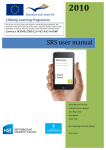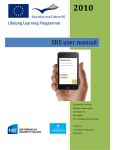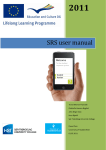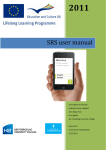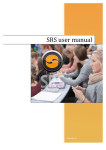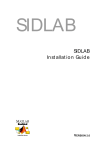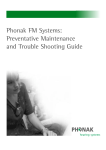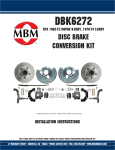Download SRS user manual - histproject.no
Transcript
2010 SRS user manual Trond Morten Thorseth Gabrielle Hansen-Nygård John Birger Stav Knut Bjørkli Pascal Pein Sør-Trøndelag University College 29.11.2010 Contents Introduction ............................................................................................................................................... 3 Getting started ......................................................................................................................................... 4 Setting up the PC used to run votes .............................................................................................. 4 Setting up the voting devices .......................................................................................................... 5 Connecting to a network................................................................................................................. 6 Adding a link to the voting server .............................................................................................. 7 Technical overview of the SRS ............................................................................................................ 7 Checklist for first-time use of the SRS........................................................................................... 8 Using the SRS in classes ........................................................................................................................ 9 The user interface for the teacher and the students during a vote ................................. 11 Using the SRS interface in conjunction with PowerPoint and similar applications .............15 Methodical best practises ....................................................................................................................16 Logistical considerations ..................................................................................................................16 Timed versus non-timed voting sessions......................................................................................16 The teacher’s role...............................................................................................................................17 Appendix A: Reference guide for the SRS control interface (SRS-Ci) ................................18 Interface overview .............................................................................................................................18 The SRS interface as a transparent layer on top of other applications...........................18 Accessing windows behind the transparent layer.....................................................................19 Running votes ....................................................................................................................................... 20 Vote options ......................................................................................................................................21 Toggling single/multiple correct answers ................................................................................21 Displaying the results of the last vote ........................................................................................21 Redirecting the voting devices ...................................................................................................... 22 Getting detailed information about each individual vote ...................................................... 22 Configuring the user interface ...................................................................................................... 23 Appendix B: Troubleshooting .............................................................................................................. 25 2 Edumecca SRS user manual November 2010 Introduction As part of the Edumecca project, a new type of student response system (SRS) for next-generation handheld devices (such as iPod Touch or iPhone) has been developed. At college or university level, classes are quite large (more than 60 students per class). Due to time constraints, it’s often not possible for the lecturer to interact directly with the students during the lecture. Furthermore, many students find it difficult or embarrassing to ask questions in class; which reduces the level of student-teacher interaction even further. Because of the lack of feedback during class, it’s difficult for the lecturer to assess how many of the students actually follow and understand what’s being taught. Conversely, from the students’ perspective, their understanding of the material is rarely put to the test during class – such tests usually take the form of written assignments and exercises which are corrected and returned weeks later. In other words, neither the teacher nor the students have a good “real-time” indicator of learning effect. Again, because of time constraints, the students are rarely given time to discuss and interact with each other during class. If a student finds it hard to understand what’s being taught in class, it is therefore difficult to gauge whether he or she is the only one who doesn’t follow the proceedings. A normal class lasts 45-60 minutes. Cognitive research indicates that attention wanes dramatically after about 20 minutes, which would indicate that unless the students are allowed some pause for thought, a significant portion of the curriculum is lost on the students during class. The main objective of the SRS is to address these issues; in particular: Break the monotony of a lecture and allow the students to actively take part in the lecture Increase teacher-student interaction Give both teacher and students “real-time” feedback on learning effect 3 This project has been funded with support from the European Commission. This publication reflects the views only of the authors, and the Commission cannot be held responsible for any use, which may be made of the information contained therein. Edumecca SRS user manual November 2010 Getting started This section describes how to get the SRS up and running. The two basic steps are 1) Setting up the PC used to run votes 2) Setting up the voting devices (handheld device/PC). Setting up the PC used to run votes 1. Make sure the PC you’re going to set up has internet access – this is a requirement for using the SRS once it’s been properly installed 2. Download the Adobe AIR installer from http://get.adobe.com/air 3. Double-click on the downloaded file and follow the on-screen instructions for installing Adobe AIR 4. Double-click the SRS-Ci installer which can be found on the supplied memory stick file (this file has the extension .air) and follow the on-screen instructions. Keep this option 5. The SRS will start automatically after the installation, if this option was selected 6. To start the SRS manually, double-click the icon on the desktop 7. When the SRS interface is started, the following dialogue box appears: 4 This project has been funded with support from the European Commission. This publication reflects the views only of the authors, and the Commission cannot be held responsible for any use, which may be made of the information contained therein. Edumecca SRS user manual November 2010 teacher teacher Playground HiST 1.6 8. Log in using the credentials listed above, then pressing the Login button 9. The following dialogue box appears: 10. If you want to use an existing session code1, select one in the list, then press Run with existing session. To create a new session code, press Create New Session. 11. The system is now ready to run votes. The session code is displayed in the upper left corner on the screen (see below). Session code Setting up the voting devices The SRS is a web application, and any HTML-compliant device can be used to cast votes – PCs, laptops or mobile devices all work equally well. 1 The session code is a unique identifier for a particular voting session. The same session code has to be entered on the voting devices to link them to this particular session (as there can be many sessions running in parallel, used by different teachers/classes). 5 This project has been funded with support from the European Commission. This publication reflects the views only of the authors, and the Commission cannot be held responsible for any use, which may be made of the information contained therein. Edumecca SRS user manual November 2010 The only requirement for the voting device, other than HTML-compliance, is internet access. Connecting to a network The voting devices need to communicate with the voting server, and therefore need internet access. If you’re using a wireless device (such as a laptop PC, mobile phone, or other handheld device), you need to connect to a wireless network. Consult the manual of the device in question to set up internet access for the voting device. 6 This project has been funded with support from the European Commission. This publication reflects the views only of the authors, and the Commission cannot be held responsible for any use, which may be made of the information contained therein. Edumecca SRS user manual November 2010 Adding a link to the voting server To enable quick access to the voting interface when votes are held, a shortcut or bookmark pointing to the correct URL2 should be added on each voting device. Consult the manual of the relevant voting device (desktop PC; laptop, handheld device) for information on how to add a bookmark or shortcut to a URL. The URL to be entered on the voting device is http://aft-test.hist.no/srs/ Technical overview of the SRS The SRS consists of three main components: 1. The voting device which the students use to submit a response during a voting session. This device can be a any HTML-compatible mobile unit (e.g. PC; laptop or any HTML-compliant mobile device) 2. The control interface (SRS-Ci), which runs on a computer in the classroom and is used to set up and run voting sessions by the teacher 3. The SRS server, which coordinates the communication between the control interface (SRS-Ci) and the voting devices. The server also stores all the data of each individual voting session, so that the data can be analyzed at any time A graphical representation of how the various components of the SRS work together can be found below: Wired or wireless network Laptop/PC running the control interface (SRSCi) for running votes 2 SRS server which collects votes, and processes and stores data A URL means a standard web link, such as http://wikipedia.org Wired or wireless network Voting devices used by the students to cast votes 7 This project has been funded with support from the European Commission. This publication reflects the views only of the authors, and the Commission cannot be held responsible for any use, which may be made of the information contained therein. Edumecca SRS user manual November 2010 Checklist for first-time use of the SRS To ensure that the students take well to the idea of using SRS in class, it’s important that the students are properly introduced to the system before it’s used for the first time. We recommend that the following checklist be completed before the SRS is used in class: Have a one or more colleagues check that the quiz questions are clear and unambiguous Check that the classroom in which the SRS is to be used has sufficient wireless network coverage (if wireless units are to be used). If a computer lab with PCs is to be used, ensure that there’s sufficient bandwidth available Make sure the SRS interface is properly installed and tested on the teacher’s computer If handheld voting units are to be handed out to the students, make sure they are fully charged and properly configured (e.g. set up for wireless network access with proper SSID, WEP passwords etc.). If the students use personal laptops or PCs, make sure the web shortcut to the voting interface has been added Make sure that the logistics of handing out voting devices (if handheld units are used) are under control When the class starts, hold a 15-minute introduction to the SRS, during which the purpose of the SRS is explained, and the students are made familiar with the interface on the devices used for casting votes 8 This project has been funded with support from the European Commission. This publication reflects the views only of the authors, and the Commission cannot be held responsible for any use, which may be made of the information contained therein. Edumecca SRS user manual November 2010 Using the SRS in classes Below is a timeline of a typical SRS session, with images illustrating each step of the process: Students have access to a voting device in the form of a laptop, PC or mobile device The students are presented with a multiple-choice quiz question, where only one alternative correct The students are given time to discuss between themselves From the SRS interface, the teacher starts the voting session (a timer/countdown mechanism can be used, if desired) 9 This project has been funded with support from the European Commission. This publication reflects the views only of the authors, and the Commission cannot be held responsible for any use, which may be made of the information contained therein. Edumecca SRS user manual November 2010 Each student casts a vote as to what the correct answer is, using the voting device. The vote closes and the results are shown to the students in the form of an histogram The instructor will comment the various alternatives and highlight the correct one – explaining thoroughly why it’s the correct one; and why the other ones are incorrect The lecture proceeds as normal To further illustrate the process of using the SRS in class, the table below shows the process from the perspective of both the teacher (who sets up the voting session) and the students (who submit the vote/response using the voting units). 10 This project has been funded with support from the European Commission. This publication reflects the views only of the authors, and the Commission cannot be held responsible for any use, which may be made of the information contained therein. Edumecca SRS user manual November 2010 The user interface for the teacher and the students during a vote Teacher user interface (run on a PC in the classroom) Student user interface (run on a PC, laptop or mobile device) 1 The teacher starts the control interface by double-clicking the SRS icon on the desktop of the PC used to run votes The students turn on their PC/laptop/mobile device 2 The teacher logs on to the server which hosts the session and opts to either create a new session code, or use an existing session code. The students access the SRS student interface by clicking the web shortcut on their desktop (or by typing the address specified n the section Setting up the voting devices, which opens up a web browser session 3 Toolbar is partially hidden by default The starting page with the session code appears MJV MJV The students type in the designated session code and optionally their name (enables the system to track who votes what) and the page “please wait” appears – this page is a confirmation to the students that the session code has been correctly set and that the device is ready for voting 11 This project has been funded with support from the European Commission. This publication reflects the views only of the authors, and the Commission cannot be held responsible for any use, which may be made of the information contained therein. Edumecca SRS user manual November 2010 4 The students discuss between themselves what the correct answer is The quiz question is shown to the students, and the students are instructed to start discussing between themselves 5 Move cursor here The students continue their discussion while the teacher prepares for the vote The teacher moves the mouse cursor to the toolbar which is partially hidden at the right hand side of the screen. Once visible, the teacher clicks the button Automatically display results? 6 Ticking clock on/off Timer on/off Set timer MJV Toggle single/multiple correct answers The teacher selects the relevant options for the vote, and selects the appropriate question type to initiate the vote. Note that The students are ready to vote clicking the button toggles the option for multiple correct answers 12 This project has been funded with support from the European Commission. This publication reflects the views only of the authors, and the Commission cannot be held responsible for any use, which may be made of the information contained therein. Edumecca SRS user manual November 2010 7 MJV Once a question selection is made the play controller appears. Press (play), and the vote is in progress. The vote can be paused The students cast their votes at any moment by pressing (the students can continue voting while the session is paused, but the countdown stops) 8 CKS The vote is in progress Each student receives a confirmation that the vote has been registered. They can change their mind at any time by clicking another button. They can also select multiple correct answers, if this option is enabled by the teacher 9 MJV Once the vote is closed, a histogram of the votes appears. The histogram can be moved freely around The voting units are ready for another vote 13 This project has been funded with support from the European Commission. This publication reflects the views only of the authors, and the Commission cannot be held responsible for any use, which may be made of the information contained therein. Edumecca SRS user manual November 2010 10 The teacher highlights the correct answer by clicking on the bar corresponding to the correct alternative, and explains why the alternatives are correct or incorrect In our experience, the students very keen to “defend” their vote when challenged by the teacher (the teacher may challenge some of the students to explain why they voted as they did) 14 This project has been funded with support from the European Commission. This publication reflects the views only of the authors, and the Commission cannot be held responsible for any use, which may be made of the information contained therein. Edumecca SRS user manual November 2010 Using the SRS interface in conjunction with PowerPoint and similar applications As detailed in Appendix A: Reference guide for the SRS control interface (SRS-Ci), the SRS control interface puts itself as a transparent layer on top of other applications, which makes it easy to show questions on the computer running the SRS. If the computer running the SRS is connected to a projector, the recommended method for showing the quiz question to the students would be to use PowerPoint or similar application running on the SRS computer. Click here to reveal the toolbar A PowerPoint slide show with the toolbar The same slide show with the toolbar hidden at the right-hand side of the screen revealed, ready to run a vote The figure below illustrates the scenario in which the PC with the SRS installed is used to display quiz questions: Laptop or PC with SRS interface and PowerPoint Video projector 15 This project has been funded with support from the European Commission. This publication reflects the views only of the authors, and the Commission cannot be held responsible for any use, which may be made of the information contained therein. Edumecca SRS user manual November 2010 Methodical best practises Rigorous testing of various methodical approaches is being planned, to see which approach maximizes learning effect. At this stage, no statistically valid results are available from our testing. Based on observations so far, however, on a purely qualitative basis, it appears that the peer instruction approach (in which each student is given time to think through the question before the group discussion) engages the students to a greater extent than going directly into a group discussion before the vote is cast. Logistical considerations The SRS is designed to be used in large classes, and the server/client infrastructure is vey scalable. However, the simple task of handing out handheld units for hundreds of students can present a logistical challenge. The most efficient way to distribute a large number of handheld units is to have the students pick up a unit as they enter the classroom, and hand it back as they leave the class. Alternatively, handheld units can be given on loan to the students at the start of a term, on the condition that the unit is handed back in at the end of the term. In this scenario, each student would be individually responsible for his or her unit – making sure it’s charged; bringing it to classes and so on. Timed versus non-timed voting sessions The SRS is designed to be used in large classes, and maintaining order and discipline is a priority. After a group discussion, the teacher will want to start a voting session. But it can be challenging to restore order and attention in a class in which hundreds of students have been engaged in serious discussion. In particular, to make all the students, some still fiercely involved in the discussion, aware that a voting session is about to begin. To aid the teacher in restoring order for the voting session, the SRS can be set to play back a “ticking clock” sound during the countdown (see below). 16 This project has been funded with support from the European Commission. This publication reflects the views only of the authors, and the Commission cannot be held responsible for any use, which may be made of the information contained therein. Edumecca SRS user manual November 2010 Setting the ticking clock sound Our experience shows that using such a sound is invaluable in shifting the students’ attention away from the discussion, and over to the voting session in progress. In our experience, a 30-second countdown is sufficient – any longer than that and the students quickly lose patience. Remember that when the vote starts, the students have already completed their discussions and made up their minds. Therefore, 30 seconds should be enough for everybody to cast a vote. The teacher’s role Based on the feedback we’ve received, it’s critically important for the students that the teacher Thoroughly explains what the correct alternative was, and why Puts a lot of effort into stimulating the discussion between the students – in some classes, the discussion can be a bit heavy-going unless the teacher aids the process along. This problem is exacerbated if the students don’t know each other very well 17 This project has been funded with support from the European Commission. This publication reflects the views only of the authors, and the Commission cannot be held responsible for any use, which may be made of the information contained therein. Edumecca SRS user manual November 2010 Appendix A: Reference guide for the SRS control interface (SRS-Ci) This section explains all the various features of the SRS control interface (SRS-Ci). Interface overview Session code generated by the SRS server This should correspond to the current screen resolution (if the resolution changes, you may have to adjust this figure manually) Click here to hide/reveal the toolbar Start voting session See results of last vote Redirect voting units to another URL Detailed information of all voting sessions on the server Customize the user interface Exit the application The SRS interface as a transparent layer on top of other applications The SRS control interface (SRS-Ci) has been designed to put itself as a transparent3 layer on top of other applications which run on the computer. When the toolbar is hidden, the transparent layer is invisible. Once the toolbar is revealed, the interface puts itself on top of the other windows that are open on the computer. 3 The opacity of the layer can be adjusted by clicking on the Configure button 18 This project has been funded with support from the European Commission. This publication reflects the views only of the authors, and the Commission cannot be held responsible for any use, which may be made of the information contained therein. Edumecca SRS user manual Click here to reveal the toolbar Bar is hidden at the right-hand side of the screen November 2010 Click here to hide the toolbar Bar visible at the right-hand side of the screen Accessing windows behind the transparent layer The SRS has been designed to facilitate a smooth transition between showing e.g. a PowerPoint with a quiz question, and starting a vote. In certain situations it’s necessary to hide the toolbar in order to access windows and menus behind the transparent layer: When the toolbar is visible and the transparent layer is active, it’s not possible to click icons or windows which are lying “behind” the top of the transparent layer. In order to access those windows, you have to click the toolbar as indicated above to hide the toolbar. 19 This project has been funded with support from the European Commission. This publication reflects the views only of the authors, and the Commission cannot be held responsible for any use, which may be made of the information contained therein. Edumecca SRS user manual November 2010 Menus hidden behind the transparent layer are not accessible when the toolbar is visible Running votes Clicking on the button opens up the question type dialogue box, in which the teacher chooses the number of alternatives for the quiz, and the various options for the vote: 20 This project has been funded with support from the European Commission. This publication reflects the views only of the authors, and the Commission cannot be held responsible for any use, which may be made of the information contained therein. Edumecca SRS user manual November 2010 Vote options Automatically display results after the vote on/off Ticking clock sound on/off Timer on/off Toggle single/multiple correct answers (the latter enables the students to select multiple correct alternatives) Click to select more than 5 alternatives (up to 20) Once you click on a question type button (e.g. ), a vote controller pops up (see below): Set countdown timer Click on the vote to start Click to pause the vote and to stop the vote and display the results The students can continue to cast their votes while the session is paused, but the countdown will stop until the button is pressed to resume the vote. Toggling single/multiple correct answers Pressing the button toggles the option for multiple correct answers – this way, the students can select multiple correct alternatives when they cast their votes. Once the multiple correct answers option is toggled, the button changes into . Click the button again to revert to single correct answer mode (in which the students can only select one correct alternative during the vote). Displaying the results of the last vote Clicking the session: button brings up a histogram for the results of the last voting 21 This project has been funded with support from the European Commission. This publication reflects the views only of the authors, and the Commission cannot be held responsible for any use, which may be made of the information contained therein. Edumecca SRS user manual November 2010 Redirecting the voting devices The button is used to redirect the voting devices, by replacing the default “Please wait” page with a page containing a link specified with the teacher (see below): In this example, the Redirect button sends the voting devices to an online survey Getting detailed information about each individual vote The button opens up the interface for viewing detailed information about every voting session which is stored on the SRS server. 22 This project has been funded with support from the European Commission. This publication reflects the views only of the authors, and the Commission cannot be held responsible for any use, which may be made of the information contained therein. Edumecca SRS user manual November 2010 Export data to file Access raw (XML) data Analyze responses Select a voting session Select a particular vote within the session Graphs from a particular vote Shows the number of responses for each alternative for the selected session List of all voting devices used in the vote, with details about each unit (response, response time etc.) Configuring the user interface Clicking on the button brings up the dialogue box for customizing the user interface of the SRS: 23 This project has been funded with support from the European Commission. This publication reflects the views only of the authors, and the Commission cannot be held responsible for any use, which may be made of the information contained therein. Edumecca SRS user manual November 2010 URL to the voting server – this is the address entered on the voting device Color scheme for results graphs Background color and opacity 24 This project has been funded with support from the European Commission. This publication reflects the views only of the authors, and the Commission cannot be held responsible for any use, which may be made of the information contained therein. Edumecca SRS user manual November 2010 Appendix B: Troubleshooting Problem Casting a vote on one voting device triggers a response on the other units (it’s as if an “invisible hand” pushes the buttons on the other units) The vote is in progress, but the voting device still displays the “System is ready for use. Please wait for the voting to start” page Solution Delete all the cookies on all the voting devices (consult the help pages of your web browser on how to do this) Refresh the web page on the voting device by pressing the Refresh button 25 This project has been funded with support from the European Commission. This publication reflects the views only of the authors, and the Commission cannot be held responsible for any use, which may be made of the information contained therein.

























